
AVP layoffs stump PACS industry
A round of job cuts at PACS developerAdvanced Video Products (AVP) has industry observers guessingat the intentions of parent E-Systems, which bought AVP in 1992(SCAN 11/4/92). About 13 AVP employees were let go, includingat least two high-ranking
A round of job cuts at PACS developerAdvanced Video Products (AVP) has industry observers guessingat the intentions of parent E-Systems, which bought AVP in 1992(SCAN 11/4/92). About 13 AVP employees were let go, includingat least two high-ranking executives and several recently hiredsalespeople. AVP had approximately 50 employees before the reductions.
AVP, of Westford, MA, has maintained a relatively low profilesince it was acquired by E-Systems. E-Systems put AVP's salesand marketing efforts on hold while it sorted out the company'smanagement team, bringing on Cemax veteran Gil Peterson to headthe company earlier this year (SCAN 2/2/94). AVP said it wouldmove rapidly in the PACS market after Peterson's appointment asvice president and general manager.
The staff reductions indicate that E-Systems may be again reevaluatingits approach to PACS. Tom Goliash, AVP founder and vice presidentof business development at E-Systems Medical, confirmed that thecompany was downsizing but said that it remained committed tothe medical market. He declined to elaborate further.
AVP is developing a Unix-based software platform, with theintention of unveiling a product at this year's Radiological Societyof North America meeting.
Newsletter
Stay at the forefront of radiology with the Diagnostic Imaging newsletter, delivering the latest news, clinical insights, and imaging advancements for today’s radiologists.




























